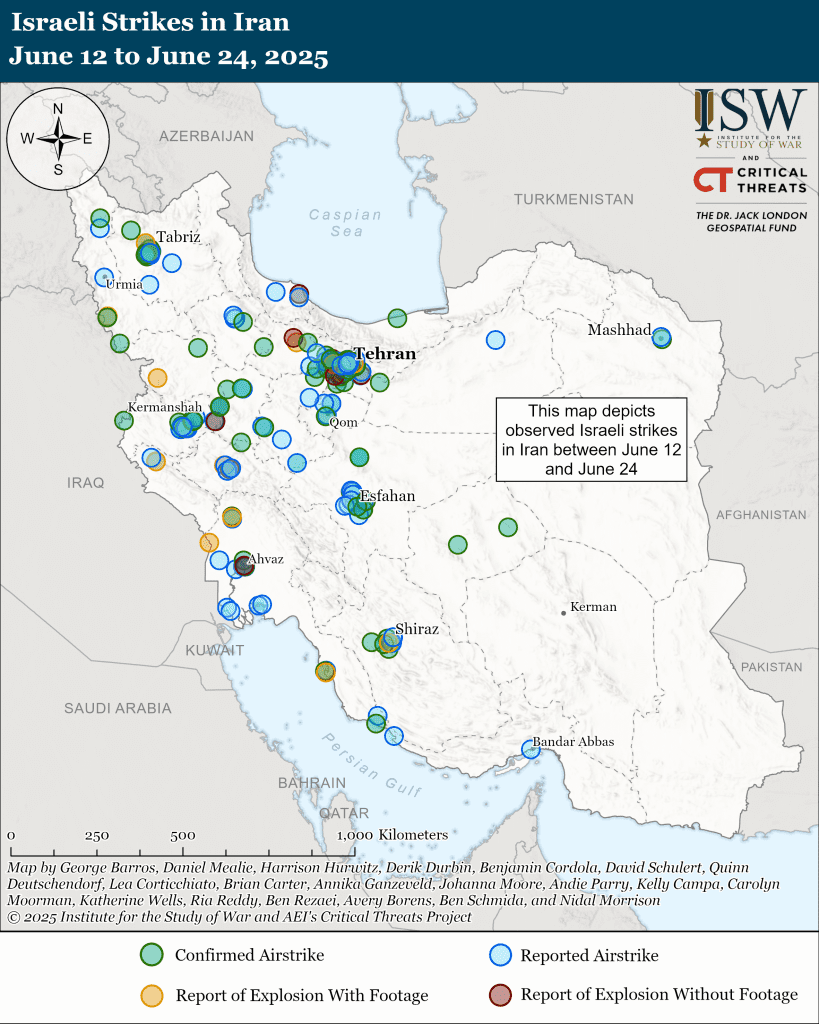Special Report on Iran, June 24, 2025, Evening Edition
By Avery Borens, Ben Schmida, Ben Rezaei, Ria Reddy, Kelly Campa, Johanna Moore, Carolyn Moorman, Andie Parry, and Brian Carter
Information Cutoff: 5:00 PM ET
The Critical Threats Project (CTP) at the American Enterprise Institute and the Institute for the Study of War (ISW) publish multiple daily updates analyzing the ongoing war with Iran. The morning update centers on the exchange of fire between Iran and Israel, while the evening edition offers a more thorough overview of the previous 24 hours and refines the morning discussion.
Click here for an interactive map of all strikes in Iran since June 12, along with a timelapse view of daily attacks.
Ceasefire Announcement and Israel’s Air Campaign
Due to the ceasefire between Israel and Iran, CTP-ISW will not publish a morning update; future analysis will appear solely in the evening updates unless there are significant events requiring morning coverage.
Israel recently executed a two-week air campaign aimed at diminishing the threat posed by Iran’s nuclear program. Israeli Prime Minister Benjamin Netanyahu claimed “Operation Rising Lion” successfully met Israel’s objectives, including the removal of Iran’s nuclear threat. Israel regards Iran’s nuclear endeavors as a critical danger and has taken action to prevent Iran from weaponizing its program. The Israeli efforts, with support from the U.S., involved destroying key nuclear facilities and assassinating leading nuclear scientists, which effectively crippled Iran’s enrichment capabilities.
Strategic Bombings and Retaliations
Israel’s campaign also targeted Iranian ballistic missile capabilities to limit potential retaliatory strikes. Iran initially intended to fire a considerable number of missiles in retaliation but was forced to launch significantly fewer due to Israeli airstrikes, which successfully neutralized much of Iran’s missile capabilities.
Additionally, Israel sought to pressure the Iranian regime into accepting a ceasefire by creating a perception of an imminent existential threat, aiming to destabilize the regime indirectly. Israeli military leaders directed intensified strikes against institutions essential for regime stability, hoping these actions might empower the Iranian populace to rise against their government.
Impacts on Iran’s Nuclear Program
The Institute for Science and International Security has concluded that the U.S. and Israeli strikes have nearly dismantled Iran’s enrichment program. Iran is left with some stockpiles of enriched uranium but will face challenges in restoring its enrichment capabilities to previous levels due to losses in infrastructure and personnel. The assessment suggests that significant time will be required before Iran can effectively rebuild its nuclear program.
U.S. Stance and Iranian Response
U.S. President Donald Trump reaffirmed the demand that Iran should not possess any uranium enrichment capabilities. Following a ceasefire, discussions began regarding the terms of future nuclear negotiations involving Iran, though it remains uncertain whether Iran will agree to the U.S. stipulation for zero enrichment.
Latest Developments
As of June 24, the Israeli Defense Forces (IDF) intercepted drones originating from Iran, indicating potential ceasefire violations. This incident marks the first drone launch from Iran towards Israel since the ceasefire began. Situations continue to unfold rapidly, affecting military and political strategies in the region.
Key Takeaways
- Israel’s campaign to dismantle Iran’s nuclear capabilities has seen significant success, supported by U.S. operations.
- The limited airstrikes on Iranian internal security structures suggest a strategic focus on demonstrating threats rather than outright regime change.
- Assessment indicates Iran’s nuclear enrichment capabilities have been gravely impaired, complicating future enrichment efforts.
- Despite Iran’s attempts at missile strikes, Israeli defenses have maintained a high interception rate, further highlighting the limitations of Iranian military capabilities.



